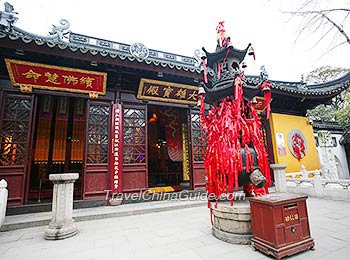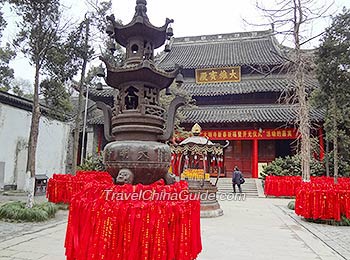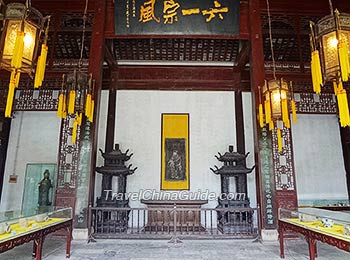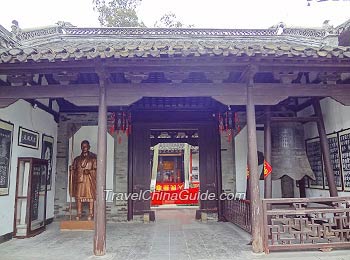Situated in a northwestern suburb of Yangzhou city, Jiangsu Province, the Daming Temple combines together a number of attractions, including religious buildings, important historical sites and beautiful gardens. It was first built in the Southern Dynasties (420-589), although has undergone numerous renovations and expansions since that time. The temple has assumed many different names during its 1500-year history, although in 1980 it reverted back to its original title.
 | | The Mahavira Hall | |  | | Gate of Temple | |
The temple building itself is similar in both style and structure to other Chinese temples. On entering the temple gate, visitors are greeted by a stately archway that was built in memory of the old Qiling Tower. The hall behind the archway is the Hall of Heavenly Kings, in the center of which sits the big-stomached Maitreya Buddha, smiling widely to welcome guests and visitors. The next hall is the Mahavira Hall, the main focus of the temple. This hall is dedicated to the Great Buddha, Sakyamuni. His figure dominates the center of the room while statues of other Buddhist gods surround him. These gods are responsible for the good harvest and peaceful life of the people. The remaining space is that of the Scripture Repository. The structures in this area date back to the Qing Dynasty (1644-1911).
Daming Temple has been a famous tourist attraction for hundreds of years. Part of its appeal lies in its sites of historical and cultural importance, principally the Pingshan Hall, built by Ouyang Xiu-a widely-known Song Dynasty (960-1279) Poet, and the Gulin Hall, built by Su Dongpo to commemorate the life of his teacher, Ouyang Xiu. Many famous Chinese poets, such as Li Bai, Liu Yuxi, Bai Juyi and Su Dongpo visited the site and wrote numerous poems to praise its charm.
 | | The Memorial Hall | |  | | Jianzhen Memorial Hall | |
The garden area is decorated with pools, elegant pavilions, oddly-shaped false hills, lush trees and fragrant flowers. However, the most spectacular feature is the Qiling Tower. First built in the Sui Dynasty (581-618), the tower was later burnt down during the Tang Dynasty (618-907). The present structure was built in 1993. Standing 70 meters (230 feet) high, it makes it possible for visitors to take in the enchanting scenery which surrounds the temple.
Daming Temple is also famed because of Monk Jianzhen, a name familiar to many Chinese and Japanese people. Jianzhen was born in Yangzhou in the Tang Dynasty (618-907) and firstly enrolled as a monk before progressing to become the superior of the Daming Temple. On the invitation of the Japanese people, Jianzhen decided to venture across the sea to Japan in an attempt to spread the practice of Buddhism. Due to the poor navigation technology of the time, he failed on a number of occasions to complete the crossing, although eventually succeeded and was warmly welcomed by Japanese people. Jianzhen spent his final years in Japan, and made a great contribution to the cultural exchange between the two countries. Visitors can learn more about his life in the Memorial Hall of Monk Jianzhen, located to the east of the Maravira Hall.
| Admission Fee: | CNY 45 (March to May, September to November)
CNY 30 (June to August, December to February) |
| Bus Route: | take bus no. 5 or 25, and get off at Damingsi Station |
- Last updated on Apr. 08, 2021 -



